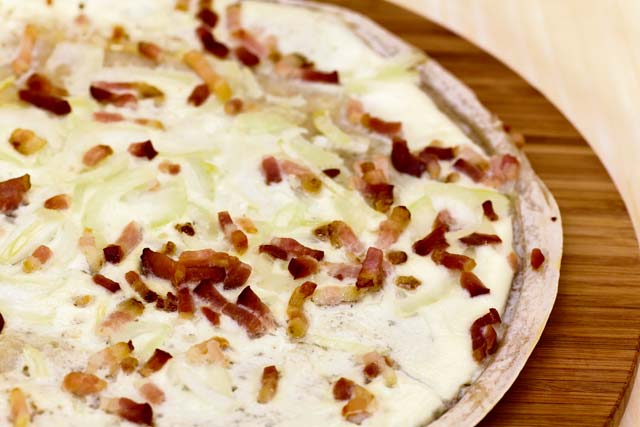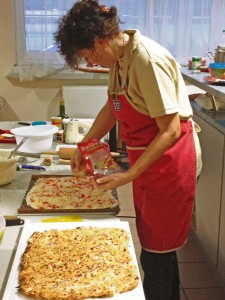
With an emphasis on meat and potatoes, German cooking isn’t as exotic as other ethnic foods, but it is hearty and appeals to the American palate.
It’s also great for family meals, and students who enroll in the German cooking classes offered by the Kaiserslautern branch of the USO typically look forward to sharing their knowledge at home.
“I want to know how to make German food so I can take these recipes back to the states, because we all eventually go home,” said Mary O’Connell of Schrollbach, who is starting a collection of German recipes.
Instructor Karin Ullrich, along with her assistant, Rafaela Koch, transform the Kapaun Chapel annex into a German “küche,” or kitchen, where students spend as much time learning how to translate recipes and cook local specialties as they do eating them.
“The class is a lot more than a cooking class,” said Beth Gross, USO assistant tours manager. “Participants receive valuable information about shopping on the economy, vocabulary and more. Friendships have developed among the regular participants, as well.”
Ullrich, of Worsbach, plans the menus, selects the recipes and shops for the ingredients at local stores. She cooks for the children at her local kindergarten and is a member of a local “Landfrauen” group of German cooks who seek to keep traditional recipes alive in the community.

Karin Ullrich, a German cooking instructor for the Kaiserslautern USO, puts the final touches on a flammkuchen dish during a recent class held at Kapaun. Using locally purchased ingredients, Ullrich taught the class how to make several varieties of the traditional dish, which originated in France and is now popular in this region of Germany.
“Karin places a lot of emphasis on fresh products and seasonal specialties when she is planning the menus, although she is not opposed to taking a short cut here or there,” Gross said.
At the beginning of each class, Ullrich hands out copies of the recipes and a packet of German cooking translations and conversions that students can take home. She outlines each recipe and points out where to find the required ingredients, especially if an item can only be found in German grocery stores. Then, with Koch’s help, she demonstrates how to make each recipe, ending with the students sampling ingredients and the end result. Students are free to ask questions along the way and take home leftovers.
“I love how she teaches us how to make meals from scratch,” O’Connell said.
O’Connell recently attended Ullrich’s class, where she learned how to make flammkuchen, one of her top 10 German meals. Flammkuchen, a specialty that originates from the Alsatian region of France, has also become popular in Germany. This “flame cake” is a dish made from a wafer-thin dough crust covered with a cream-based sauce, cheese and toppings and baked in a wood-fire oven (scroll down for a recipe).
First, Ullrich explained the various types of German flour and where to find cubes of fresh yeast to make the dough. Then, she described how to use “schmand,” a German combination of sour cream and cream cheese — combined with yogurt — to make the dish’s signature topping.
“Flammkuchen appeals to me because of its white sauce,” said Sherryl Benning of Wielerbach. “It’s not like red sauce, because it has a mild flavor compared with the pizza sauce we are used to.”
Demonstrating how to roll out the dough to a thin consistency, Ullrich then spread the sauce and added cubed ham, shredded cheese and thinly sliced onions on top.
She produced this “classic” version of the dish, followed by a dessert flammkuchen topped with apples, cream sauce, cinnamon and French apple liquor. Students were impressed when Ullrich set it on fire. Then, everyone got to try a warm slice.
“I was surprised, because I thought there was a lot more to making flammkuchen than that,” said Benning, who attended the class with four of her co-workers. “We have had it several times on trips and we wanted to learn how to make it ourselves and then share it with our families in the states.”
Benning said she’s sending her German recipes to her daughters-in-law so they can make the dishes for their husbands and kids. She plans to try making her own variety of flammkuchen using a combination of hamburger, onions and garlic.
“I love to cook, and I love the German foods I have tried, but I didn’t have the knowledge to actually make what I have tried (before the class),” she added.
The USO started the cooking classes 10 years ago as a way to introduce local culture to military families, and turnout has been phenomenal, Gross said. The USO now offers four to five classes a month, including evening classes for those who work during the day.
Upcoming classes include a hands-on German cookie baking class on Tuesday and a German holiday cooking class on Dec. 10 and 12. There is a fee to take the class, and occasionally children’s classes are offered for free. Classes are held in the Kapaun Chapel Annex and the Vogelweh Chapel kitchen.
“Of course there are popular dishes that almost everyone who comes to Germany wants to learn how to make,” Gross said, noting schnitzel is one of them. “We like to offer classes that highlight seasonal vegetables or recipes that are fitting to the season, such as pumpkin and chestnut soups, Christmas cookies, or festive Christmas or Easter menus.”
At the end of each class, the students can give feedback and suggestions, and the USO utilizes their ideas for future classes, Gross said. Since German cooking varies by region, there are plenty of options of specialties and variations of German foods — even sauerkraut.
“First and foremost, we hope that the people will take what they have learned and try the recipes at home with family or friends,” Gross added.
For more information about USO cooking classes, join the KMC USO German Cooking and Baking group on Facebook. All classes must be booked in person at any USO office. Classes are open to adults and children over 12, and participants must pre-register through the USO.
For more information, call the USO tours office at 0631-3406-4532 or email toursKL@uso.org.
CLASSIC FLAMMKUCHEN
(Courtesy of USO)
Flammkuchen dough
1 kilogram – Flour, sifted (Mehl) #405 is recommended
1 cube – Fresh yeast (Hefe)
½ tsp – Sugar (Zucker)
200 milliliters – Rapeseed/Canola Oil (Rapsöl) or other vegetable oil
600 milliliters – Water, warm (Wasser)
20 grams – Salt (Salz)
Sift the flour into a large mixing bowl. Make a well in the middle of the flour. Crumble the cube of fresh yeast into the well. Add in the sugar and the warm (not hot!) water. Stir in the oil and salt. Using the kneading attachment on your mixer, mix everything together until a mass has formed. Cover with a clean cloth and set aside for 20 to 30 minutes or until the dough doubles in size. Divide the dough into six equal pieces. As you prepare to use each portion of the dough, knead by hand for just a couple of minutes. Sprinkle flour onto a baking sheet. One portion at a time, roll the dough to edges of the pain (instead of using flour, you can also lay a sheet of baking paper on the pan and roll the dough out on that).
This dough also freezes very well. After combining the ingredients, but before letting it rise, wrap the dough in 5-6 separate packages (about 150 gram balls). When you are ready to use it, just remove it from the freezer and let it thaw in a warm oven at about 50 degrees Celsius or 120 degrees Fahrenheit for about two hours. We don’t recommend thawing the dough in the microwave. It will rise as it thaws. If using a savory topping, you can substitute the vegetable oil for olive oil (if desired). This dough is also good for pizza making.
Flammkuchen cream sauce topping
200 grams – Schmand (sour cream/cream cheese combo)
150 grams – Plain yogurt (Jogurt)
100 grams – Cooked cubed ham or smoked bacon (Speck)
To taste – Salt, pepper, nutmeg (Salz, Pfeffer, Muskatnuss)
2 medium – Onions (Zweibel)
200 grams – Gouda cheese, grated or sliced (Gouda)
Heat oven to 225-250 C (445-480 F)
Combine schmand with salt, pepper and nutmeg to taste. Spread topping on the rolled out dough from the above recipe. Chop the smoked bacon or ham into small pieces. Evenly sprinkle on to the schmand topping. Peel the onion and cut them into thin rings. Evenly spread the rings on top of the bacon/ham. Grate or slice the gouda cheese into fine strips. Evenly spread the cheese on top of the flammkuchen. Bake for 15-20 minutes on the middle rack of the oven.
(You can also substitute various types of meat, vegetables and cheese to add variety to the dish)


